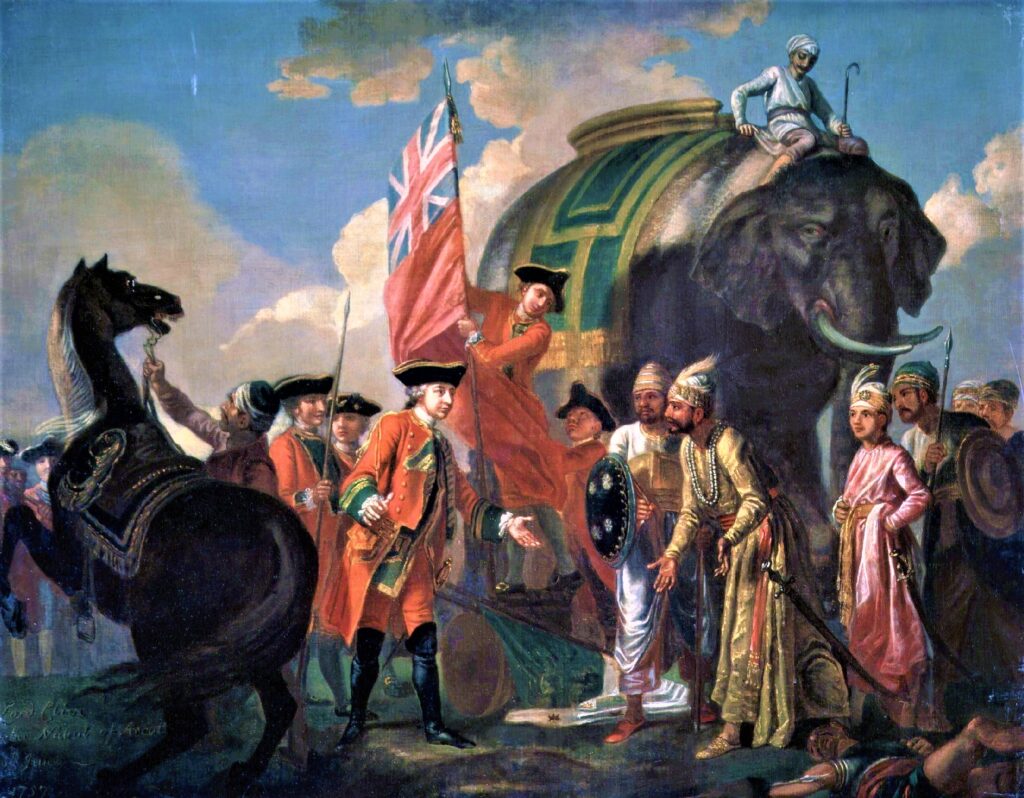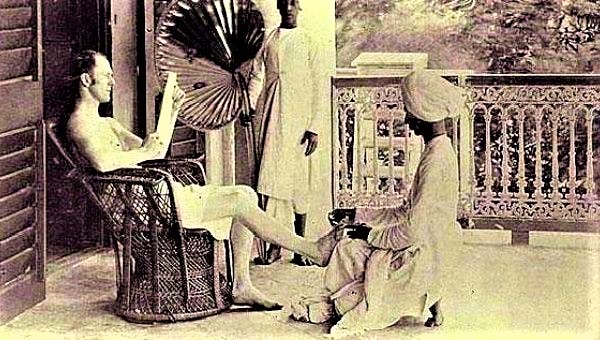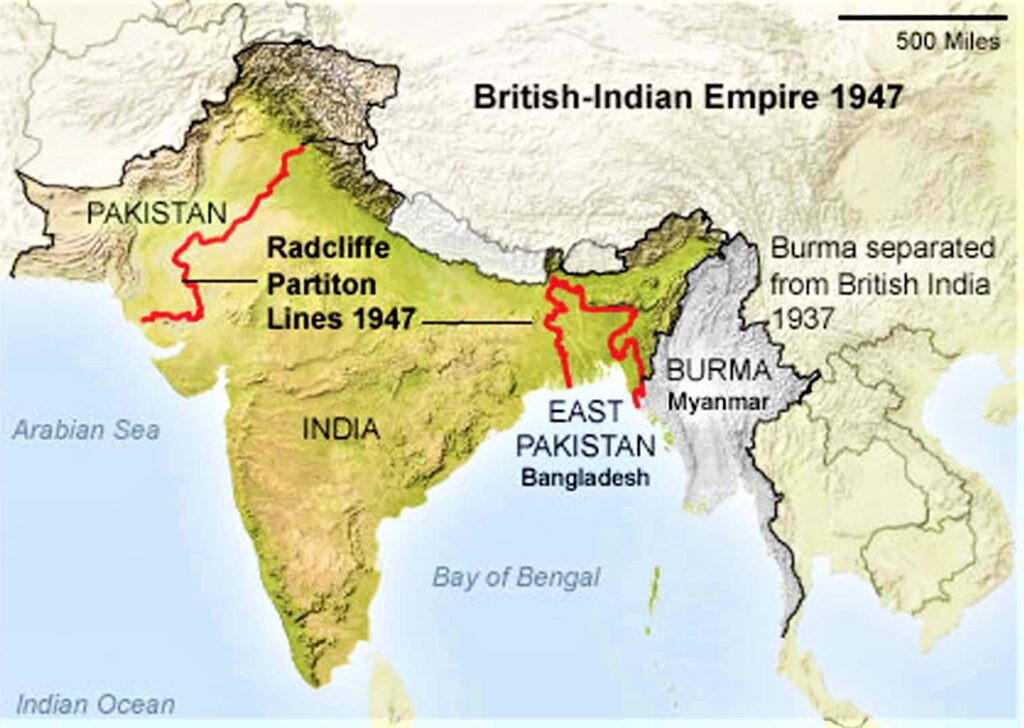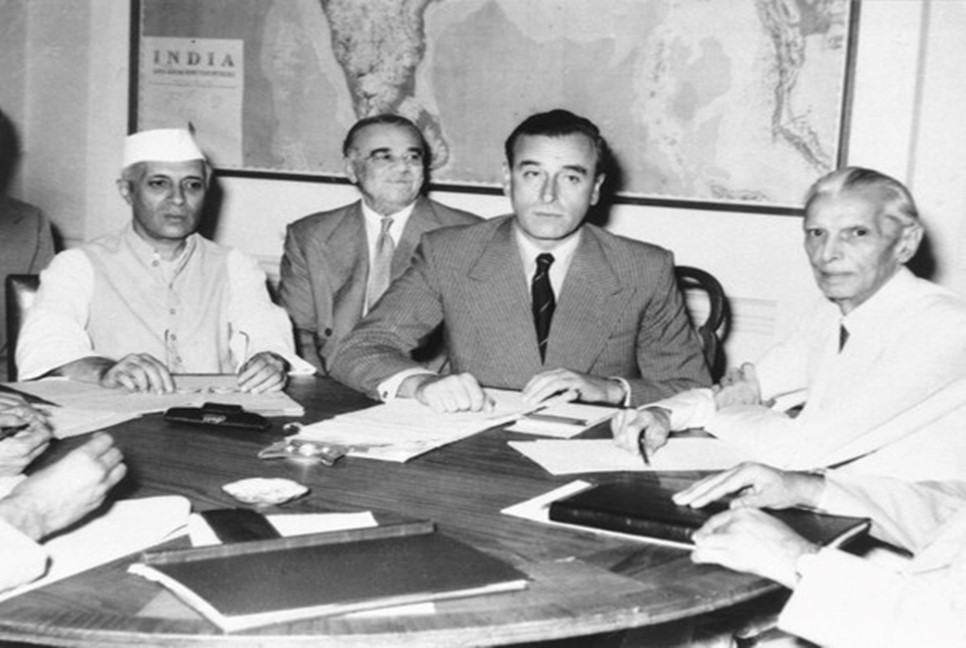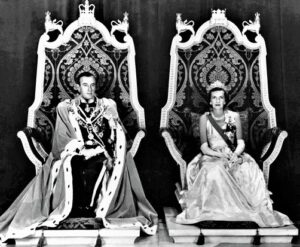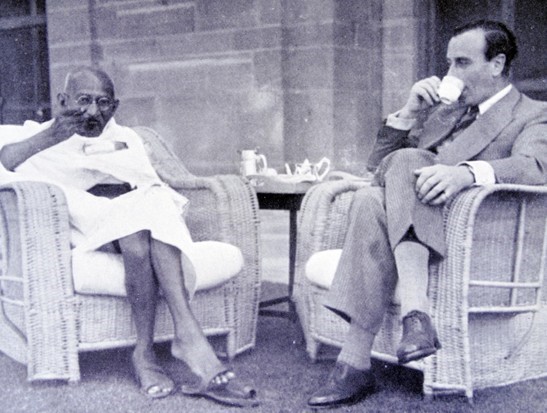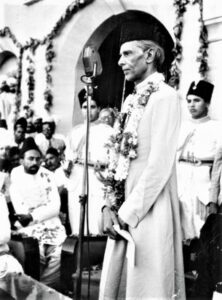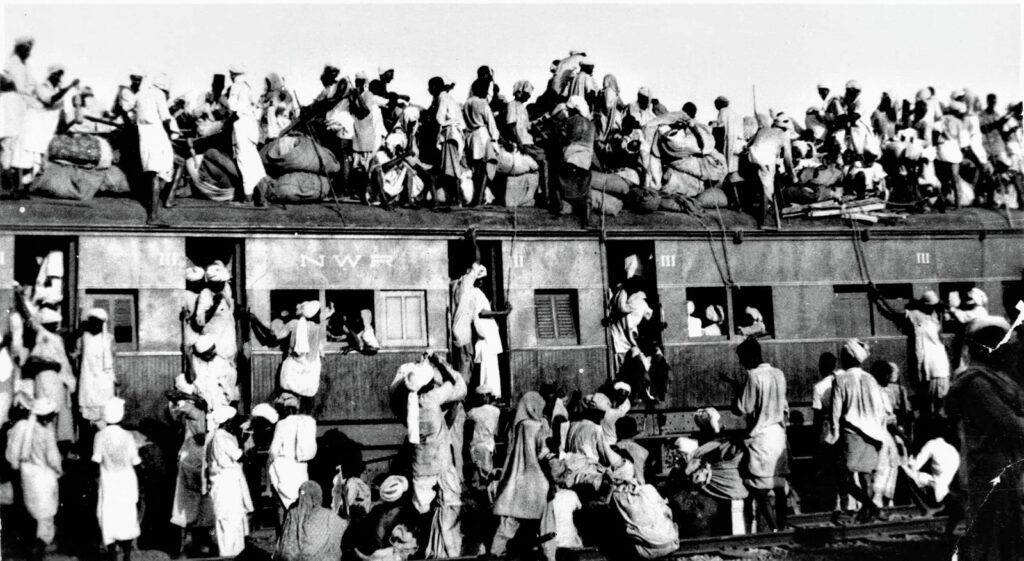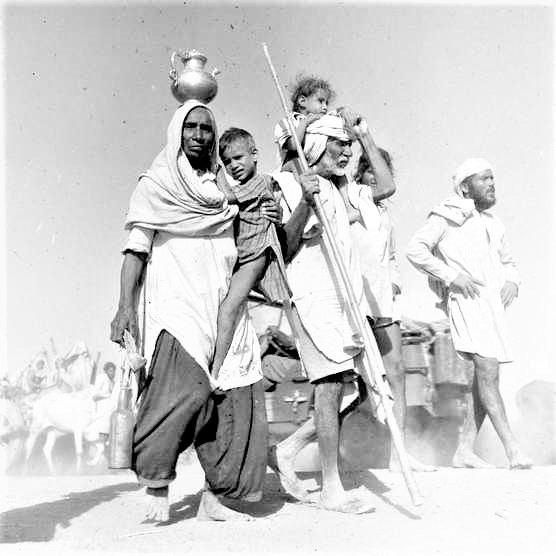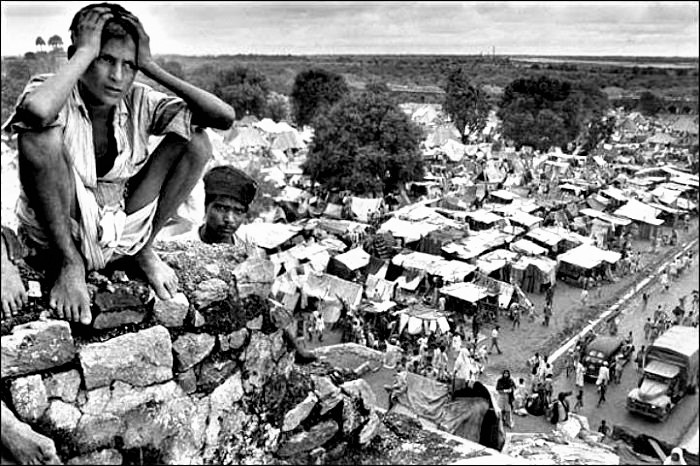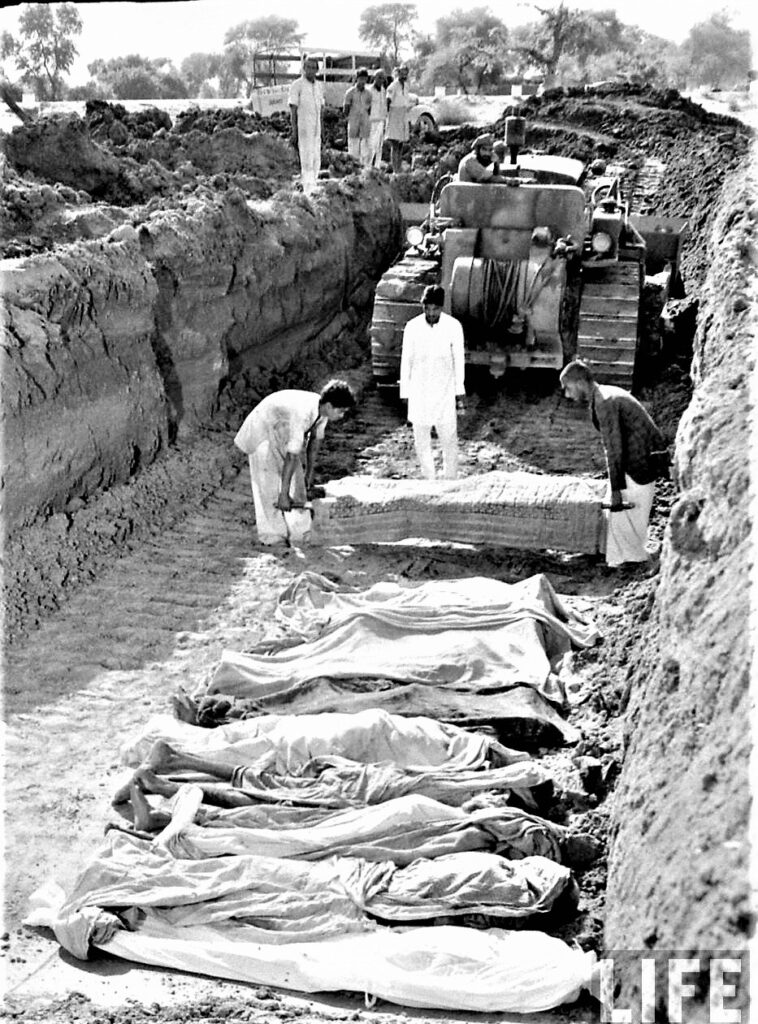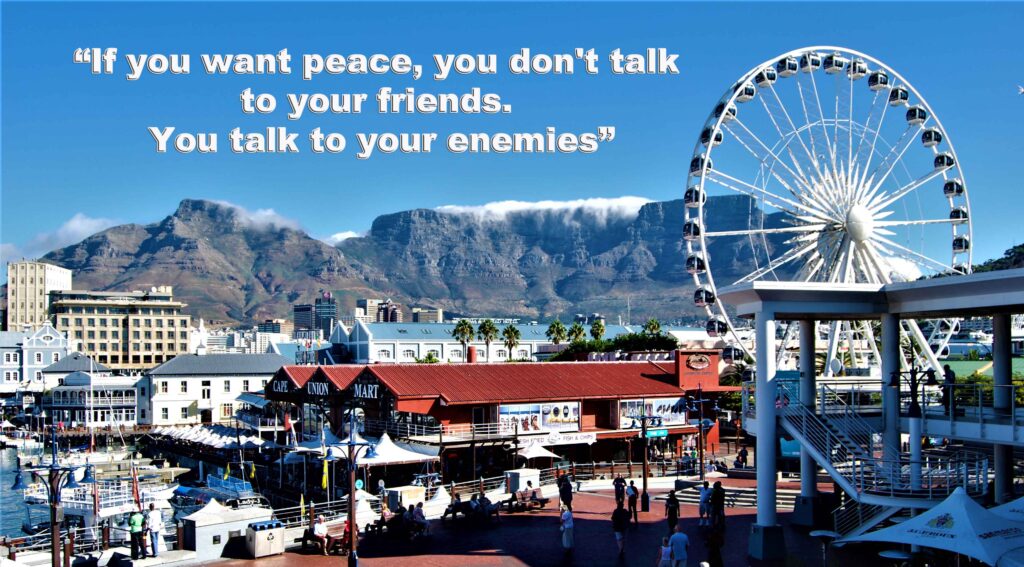The Partition of India by the British Raj: Destruction of Peace, National Cohesion and Love
TRANSCEND MEMBERS, 10 Jan 2022
Prof Hoosen Vawda – TRANSCEND Media Service
The Butchering of a Nation by the Guardians of the Civilised Western World
Britain had been trading in India since about 1600, but it did not begin to seize large sections of land until 23 June 1757, after the Battle of Plassey[1], due to the defection of Mir Jafar,[2] who was Nawab’s commander in chief. This battle pitted 3,000 soldiers of the British East India Company against the 50,000-strong army of the young Nawab of Bengal, Siraj ud Daulah, and his French East India Company allies.[3] Beginning in 1757, the British commercial enterprise known as the East India Company ruled parts of the subcontinent beginning with Bengal, a period known as the Company Rule or Company Raj. In 1858, after the brutal Sepoy Rebellion,[4] the rule of India was transferred to the English crown, with Queen Victoria proclaimed as Empress of India in 1878. Since then, British colonial rule in India lasted for 190 years. Britain established its rule in 1757, and it remained in charge of India until 1947, when violence in India and economic issues at home after World War 11, led England to relinquish control and grant Independence on 14 August 1947, at that time, England’s financial situation was in a poor state, and relinquishing India was an effective way to reduce expenditures while earning global goodwill. The Partition was a solution to the “Indian Problem”. The Partition was the arbitrary division of India into three sections based on religion: Pakistan in the West, India in the middle and East Pakistan, the present-day Bangladesh. This was the punishment meted out to the “Indian Resistance” to British rule, which resulted in butchering of up to two million citizens, a massive refugee crisis and humanitarian suffering, with the largest mass migration of humanoids since the Mongol invasion of Europe, between 21 Dec 1237 to 11 Apr 1241 in 13th Century.[5]
British imperialism drained one of its richest colony, India, of all its wealth and resources to the value of US45 trillion. The British East India Company made its sneaky entry through the Indian port of Surat in 1608. Originally the company started with a group of merchants trying to seek a monopoly over trade operations in the East Indies. In 1615, Thomas Row one of the members approached the ruling Mughal emperor Jehangir to gain permission to open the first factory in Surat. Slowly as they expanded their trade operations, the British started forming colonies. Penetrating deep into Indian politics, the imperialists took advantage of the infighting between the ruling royalty in different states, pitting one against the other by taking sides and offering protection.[7] Imperial rule destroyed India’s local hand loom industry to fund its own industrialization. India became one of the major cotton exporters to the U.K. The raw materials from India were taken to the U.K. and the finished products were sent back to Indian markets and other parts of the world, leaving the Indian handloom industry in shambles and taking jobs away from local weavers. Furthermore, the last famine in India, in Bengal between 1943 and 1944, claimed over four million lives. The Bengal is said to have been engineered as part of an unsympathetic and ruthless economic agenda, according to Rakhi Chakraborty’s book titled, “The Bengal Famine[8]: How the British Engineered the Worst Genocide in Human History for Profit.” In addition, the British, imparting the English language was a colonial instrument designed to help the British empire oppress the Indian masses. The strategic decision by the East India Company was made to create a class of Indians, the “Babus,” who could act as a bridge between the millions of Indians who did not speak the language. Secretary to the Board of Control Lord Macaulay, in a nasty 1835 “Minute on Education,” urged the Governor-General to teach English to a minority of Indians, reasoning, “We must do our best to form a class who may be interpreters between us and the millions whom we govern; a class of persons, Indians in blood and color, but English in taste, in opinions, in morals and in intellect.”[9] It is also to be noted that on Indian Railways “Dogs and Indians not allowed”. In 1843, Governor-General Charles Hardinge [10]said the construction of railways would benefit the empire and help with “the commerce, government and military control of the country.” The railroad was paid for by Indian taxpayers. The British shareholders claimed the investments guaranteed massive returns.
The colonizers were only interested in exploiting India’s natural resources as they transported items such as coal, iron ore, cotton and other natural resources to ports for the British to ship home to use in their factories, feeding the Industrial Revolution, in Britain, at the time. Indians were prohibited from riding in first class compartments in the trains that they helped build even if they could afford it, as the first compartments were labeled as “Dogs and Indians are not allowed.” Thousands of Indian workers died during the construction of the railroads. This was the precursor of apartheid, the British even introduced in South Africa, later perfected by the Nationalist apartheid government. The same philosophy was practised in China by the British colonisers, where “Coolies and Dogs not allowed” notices were found in British clubs and buildings.
The secret of British colonisation of vast empires was the age-old foreign policy of divide and rule. “The Imperialist policy of Divide and Conquer” The British Empire adopted the age-old political strategy of divide and conquer throughout their colonization of India. The occupiers used the strategy to turn locals against each other to help them rule the region. Whenever the British felt threatened by Indian nationalism and saw it growing, they divided the Indian people along religious lines. In 1905, Viceroy of India Lord Curzon[11] partitioned Bengal dividing the largely Muslim-dominated eastern section from the Hindu dominated western part. But the strategy did not last long, as Bengal was reunited in 1911. After oppressing India for nearly 200 years, draining its wealth and filling their own coffers, the British Raj ripped the Indian subcontinent into pieces just before they finally left.[12] The partition of 1947 that came along with India’s independence left nearly two million dead and 13 million displaced. Billions of dollars were lost in property left behind. The British colonised the Indian sub-peninsula, based their knowledge of the people of India on religious texts and the intrinsic differences they found in them, instead of examining how people of different religions coexisted.[13] This was the strategy of the British to destroy the country.
At the stroke of midnight on August 15, 1947, 400 million people, were liberated from the British Empire. With the loss of India, its greatest colony, Britain ceased to be a superpower, and its king ceased to sign himself Rex Imperator. This defining moment of world history had been brought about by a handful of people. On 03rd June 1947, Abdul Rab Nishtar, Sardar Baldev Singh, Acharya Kriplani, Sardar Patel, Jawaharlal Nehru, Mohammed Ali Jinnah and Liaquat Ali Khan, representatives of the Muslim League, the Sikh parties and Indian Congress, sat around a small table with the last British viceroy of India, Lord Mountbatten, and Lord Ismay, Mountbatten’s chief of staff. They agreed that the plan to partition would go ahead. Among them were Jawaharlal Nehru, the fiery Indian prime minister; Mohammed Ali Jinnah, the leader of the new Islamic Republic of Pakistan; Mohandas Gandhi, the simplistic figure in a loincloth, or dhoti, who enthralled a nation; and Louis and Edwina Mountbatten, the glamorous but unlikely couple who had been dispatched to get Britain out of India.[14]
This photograph marks the moment when fewer than a dozen men agreed to divide the whole of the Indian subcontinent, with a a population of 400 million into fragments based on religion, creating am environment fertile for unbridled sectarian violence and warring. The Indian leaders look tired and apprehensive, but Ismay (second left) smiles, perhaps with relief that an agreement has finally been reached. The plan was announced in the House of Commons in London that evening. At the same time, Mountbatten and the leaders of the different parties took to the radio to explain the decision to an expectant and nervous south Asian population
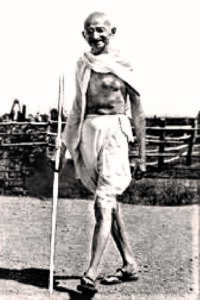
Mohandas Karamchand Gandhi, “The Mahatma”
A British trained Lawyer and a Liberation Activist, trained by South Africa and made into a struggle icon in India
Many believed that, by agreeing to a final plan, further outbreaks of violence between the country’s Hindu, Muslim and Sikh communities could be avoided. Mountbatten declared: “The whole plan may not be perfect: but like all plans its success will depend on the spirit of good will with which it is carried out.”
Within hours of the midnight chimes, the dreams of freedom and democracy of the Hindu, Muslim and Sikh Indians would turn into total chaos, macabre butchery of humanoids, especially women and children, bloodshed, and a civil war on an unprecedented scale. The Partition of India by the British Raj in 1947 created worldly chasms, specifically devised to divide the peacefully coexisting Hindus and Muslims, destroying the national cohesion and love forever in the Indian sub peninsula, with deep seated acrimony even existing in 2022. An excellent article “British Colonialism and How India and Pakistan Lost Freedom” was published by Dr Mahboob A. Khawaja, Ph.D. in TRANSCEND Media Service on 03rd January 2022 to further elaborate the pitiful background of the brutal British Raj in India.[15] In reference to the paper, it is to be noted that the British relocated the last King Thibaw of Burma, at the time. to India. After abdicating the throne, King Thibaw, his wife Supayalat and two infant daughters were exiled to Ratnagiri, India, a port city off the Arabian Sea,[16] while in exchange, the last Mughal Emperor of India, Bahadur Shah Zafar was tried in court and sentenced to life imprisonment. His sons were shot dead before his eyes. He and his wife Begum Zinat Mahal were sent to prison in Rangoon, Burma, in October 1858 and who died a pathetic death from tuberculosis, in 1862.[17] The British Raj ensured that the last living vestige of the once glorious Mughal Empire, was destroyed forever, leading to the total subjugation of India and establishment of direct British colonial rule, putting an end to any pretensions of Zafar as Emperor of India.
Mohammed Ali Jinnah[18] was the leader of the Muslim League and hero-worshipped by many south Asian Muslims. It’s fitting therefore that he led the celebrations for the new state of Pakistan in Karachi, on 14 August 1947. Behind him stand members of the Muslim League National Guard.
Educated in Britain, Jinnah often wore Savile Row suits, but on this day he sported a white sherwani (a knee-length coat) and a north Indian hat called a karakul. Despite the celebrations there was much uncertainty about the new state, and the role of religion within it. Jinnah himself was ambivalent about the territory that had been granted to Pakistan, describing it as “moth eaten”. In just over a year he would be dead, leaving Pakistan bereft of a leader who could unify many different, competing ethnic groups.
Lord Louis Mountbatten, as the last viceroy is sworn in 24 March 1947 after almost 200 years of British rule. The 1st Earl of Mountbatten and his wife, Edwina, arrived in India on 22 March 1947 and were sworn in at a lavish ceremony in the Durbar Hall of the Viceroy’s House in New Delhi two days later.[19] A great grandson of Queen Victoria, Mountbatten enjoyed theatrical ceremonies, but he also had extensive powers. As head of the British administration in India, he was responsible for planning the departure of the British from India and for finding a solution to the deadlock between the different Indian political parties.
Lady Edwina Mountbatten[20] also played a decisive role in the drama, developing an intimate personal relationship with Jawaharal Nehru, the leader of the Indian National Congress, the party that was spearheading the move towards independence. The Mountbattens’ remained in the subcontinent after independence, until June 1948, and Louis acted as first Governor-General of independent India.
Mountbatten had been dispatched to India by the British prime minister, Clement Attlee,[21] with instructions to secure the fastest possible transfer of power. Within two months of his arrival, he had finalised a plan to partition the subcontinent into two separate states: a Muslim majority Pakistan and Hindu majority India and transferred power a year faster than anyone had expected.
With partition negotiations locked in deadlock, Mahatma Gandhi and Louis Mountbatten endeavoured to find a way forward over a cup of tea in the garden of the Viceroy’s House in New Delhi. This image was a brilliant piece of propaganda, as the British needed to show to the world that they were consulting with the most important Indian nationalist leader. It shows the two men enjoying a drink that was grown on Indian plantations but had, by now, become quintessentially British.
The leaders had long discussions about Gandhi’s life in South Africa, but the conversation mostly focused on India’s political stasis. How should Mountbatten accommodate the different constitutional demands at the time of independence? Could Congress reach a compromise with the Muslim League?[22] The leaders’ meetings were cordial but Mountbatten was upset that Gandhi refused any possibility of partition as a solution (he described Gandhi as “Trotskyist” in private letters of the time). Gandhi continued to talk of British policies of ‘divide and rule’. Although, ultimately, the Congress did reluctantly agree to the partition of India, Gandhi never endorsed it. On Independence Day in August the same year, he refused to celebrate, spending the day fasting and in silent prayer.
Partition proved a harrowing experience for millions of people – and perhaps no group suffered more than Punjab’s poorest villagers. This moving image, taken by the celebrated American photographer Margaret Bourke-White, shows a Muslim mother hugging a relative besides the grave of her child. The infant had died of starvation after the family’s train was halted by ethnic violence. Bourke-White saw the refugee columns trudging across the new borders, photographed corpses on train tracks and toured cholera-afflicted hospitals. “The sight of these helpless sufferers had made me very angry,” she wrote in her account of her experiences of partition, Halfway to Freedom. “These were innocent peasants; some had been driven from their ancestral homes; the others had listened to the drumming of religious slogans and left home to pursue a dream.”[23]
Rape was used as a weapon of ethnic cleansing in Punjab, and women often suffered in their own communities because of the stigma of sexual violence. Others were held captive by the ‘other’ community, while tens of thousands were forcibly repatriated by the new states of India and Pakistan. No wonder Gandhi described women as “the chief sufferers” of partition.[24]
On 19th September 1947, trains overcrowded with refugees, packed onto the roof and clinging to the sides became the defining image of partition.[25] At least 12 million people moved between India and Pakistan, with roughly equal numbers of Hindus and Muslims seeking new homes in addition to almost the whole Sikh population. Many travelled by train, but others walked in long foot columns, while some crossed the border by car or plane. The scale of the migrations was unplanned, and caught the British and Asian politicians by surprise. Confusion followed, as some people were urged to return or to stay in their homes. In early September 1947, it became clear that the safest way forward was to exchange the populations across Punjab. This soon became official policy, organised by the military.
The majority of the refugees were from Punjab but hundreds of thousands also moved in both directions from other parts of India and Pakistan, including Bengal, Bombay, North West Frontier Province, Sind and United Provinces.[26]
In late 1946 unbridled violence blights north and east India. Extreme ethnic violence between Hindus and Muslims broke out in late 1946 in north India, particularly in the regions of Noakhali (Bengal), Bihar and the United Provinces[27]. This was different to earlier episodes, not just in scale, but also because women and children were increasingly being targeted for killings and sexual violence. Gandhi toured the afflicted regions to try and bring peace to the troubled areas.[28] He threatened to fast until death if the violence did not stop. Meanwhile, local political leaders and agitators from all communities were involved in spreading rumours and increasing ethnic tension. Muslim women were paraded in the nude , to be raped and murdered, later.
The British judge Cyril Radcliffe[29] was asked to draw the boundary between the new states of India and Pakistan. He did so with the help of south Asian members of the Bengal and Punjab Boundary Commissions, but these quickly became polarised and partisan along religious lines. Using the 1941 census, Radcliffe considered the majority and minority populations in the districts to be divided, but was also allowed to consider cultural and economic factors. The announcement of the boundary line was held back until after Independence Day. Inevitably, many were deeply disappointed by the decisions that Radcliffe made.
A total of nearly 12 million Indians, of different religious denomination were in a process of mass migration between August–October 1947.[30] The bloodshed and violence continued unabated on both sides, with entire trains arriving in India and Pakistan full of dead bodies, with blood dripping from the under carriages. Such grisly scenes were becoming a common sight at railway stations and seasoned journalist who covered the Nazi concentration camps found the carnage in Calcutta unbearable, with rotting corpses, mutilated bodies of women and children strewn around the main streets of the large city. The stench of death was ever pervasive, while politicians and instigators continued their devilish task with fiendish delight of stirring emotions and spreading false rumours amongst the different religious groups. It not only seemed, but clearly evident, that humanity was lost forever.
Finally, on 30th January, Nathuram Godse, a Hindu nationalist fiercely opposed to Mahatma Gandhi’s demands for a secular, pluralist state, and his attempts to make peace with Pakistan, walked into a prayer meeting at Birla House in New Delhi and shot the leader in the chest three times.[31] Gandhi’s assassination was a massive shock to the Indian nation and helped to bring partition violence to a halt. Nonetheless, the subcontinent would continue to be afflicted by sporadic bloodletting, and refugees would continue to cross the borders of Bengal and East Pakistan for many years and even today the two nations with a common genealogy, sharing a common colonizing foe, the British, are sill at loggerheads with each other, the only difference being religion.
The Bottom Line is summarised by Alex Von Tunzelmann[32] who takes up the story of the end of the British Empire and the creation of the independent states of India and Pakistan. She does this with great insight, commencing with the first sentences of her opening chapter: “In the beginning, there were two nations. One was a vast, mighty and magnificent empire, brilliantly organised and culturally unified, which dominated a massive swathe of the earth. The other was an undeveloped, semi-feudal realm, riven by religious factionalism and barely able to feed its illiterate, diseased and stinking masses. The first nation was India. The second was England.
Partition triggered religious riots, unprecedented violence against women and children, ethnic cleansing on both sides, of Hindus, Muslims, Sikhs and minorities, mass casualties, and a colossal wave of human migration within the Indian peninsula. Millions of people moved to what they hoped would be safer territory, with Muslims heading towards Pakistan, and Hindus and Sikhs in the direction of India. The British Raj, in their greed for the pursuit of material wealth, colonised and plundered the once unified and glorious India, as it did all over the world, including Africa, not only stealing valuable artefacts but also destroying the heritage, language and rich culture of India creating progenies of “His Master’s Voice” and puppets in the process. Ironically, the very jewels in the Royal Crown and other jewelry collections of Her Majesty, Queen Elizabeth 11 of England, originated from India and should rightfully be repatriated to the nation. Furthermore, as a parting shot, the departing British ensured, propagated, as it did in 1657 and engineered the mechanism of “The Partition”, by which the nation will be destroyed by communal riots and sectarian violence, which is even today deeply embedded in the culture of all three nations: India, Pakistan and Bangladesh, which were originally a unified subcontinent. It is a serious indictment that such strategies are even used today to divide humanoids, but the future generations need to ensure that never again such horrors of infighting, savage butchery and mass migrations will ever occur, ever again, not only in India as a whole, but globally as well. Humanoids must strive for peace at all times. The words of the late Archbishop Desmoid Mpilo Tutu are eternal: “If you want peace, you don’t talk to your friends. You talk to your enemies”.[33]
References:
[1] https://en.wikipedia.org/wiki/Battle_of_Plassey
[2] https://en.wikipedia.org/wiki/Mir_Jafar
[3] https://www.bing.com/search?q=when+did+the+british+colonise+india&cvid=d01488f9930a4a21ac04538aa4dc8dd3&aqs=edge.0.0l3.102456j0j1&pglt=43&FORM=ANNTA1&PC=U531
[4] https://en.wikipedia.org/wiki/Indian_Rebellion_of_1857
[5] https://www.bing.com/search?q=When+was+Mongol+invasion+ofEurope&cvid=aede2637a2ac4a798eb210133cf359da&aqs=edge..69i57.20399j0j1&pglt=43&FORM=ANNTA1&PC=U531
[6] https://www.bing.com/search?q=ResourcesforHistoryTeachers+WikiSpaces&aqs=edge..69i57.2536941j0j9&pglt=43&FORM=ANNTA1&PC=U531
[7] https://www.telesurenglish.net/news/5-Ways-the-British-Empire-Ruthlessly-Exploited-India-20170425-0033.html
[8] https://www.researchgate.net/profile/Rakhi-Chakraborty
[9] https://www.telesurenglish.net/news/5-Ways-the-British-Empire-Ruthlessly-Exploited-India-20170425-0033.html#:~:text=Imparting%20the%20English,and%20in%20intellect.%E2%80%9D
[10] https://en.wikipedia.org/wiki/Charles_Hardinge,_1st_Baron_Hardinge_of_Penshurst
[11] https://byjus.com/free-ias-prep/lord-curzon-important-insights-for-civil-services/
[12] https://www.telesurenglish.net/news/5-Ways-the-British-Empire-Ruthlessly-Exploited-India-20170425-0033.html#:~:text=The%20Imperialist%20policy,property%20left%20behind.
[13] https://www.bing.com/search?q=A+summary+of+British+rule+in+India+Thoughtco&cvid=e8bf5532c1024c048a0e2a565dd08fe0&aqs=edge..69i57.26216j0j1&pglt=43&FORM=ANNTA1&PC=U531
[14] https://www.amazon.com/Indian-Summer-Secret-History-Empire-ebook/dp/B008KP35TU/ref=tmm_kin_swatch_0?_encoding=UTF8&qid=&sr=#:~:text=The%20stroke%20of,bloodshed%2C%20and%20war.
[15] https://www.transcend.org/tms/2022/01/british-colonialism-and-how-india-and-pakistan-lost-freedom/
[16] https://en.wikipedia.org/wiki/Thibaw_Min
[17] https://www.foreignaffairs.com/reviews/capsule-review/2007-11-01/last-mughal-fall-dynasty-delhi-1857-indian-summer-secret-history
[18] https://en.wikipedia.org/wiki/Muhammad_Ali_Jinnah
[19] https://www.thesun.co.uk/news/9752565/inside-lord-mountbatten-marriage/
[20] https://en.wikipedia.org/wiki/Edwina_Mountbatten,_Countess_Mountbatten_of_Burma
[21] https://en.wikipedia.org/wiki/Clement_Attlee
[22] https://www.historyextra.com/period/20th-century/bloody-road-partition-india-pakistan-gandhi-mountbatten-viceroy/
[23] https://www.cambridge.org/core/journals/journal-of-the-royal-asiatic-society/article/after-the-massacres-nursing-survivors-of-partition-violence-in-pakistan-punjab-camps/A306445A415255571B5A739D5CB31A3B
[24] https://www.refworld.org/docid/3ae6a87a0.html
[25] https://artsandculture.google.com/asset/1947-partition-refugees-travelling-via-train/HgF-9XTDAO-R3Q
[26] https://www.jstor.org/stable/24355263
[27] https://www.sciencespo.fr/mass-violence-war-massacre-resistance/en/document/india-1900-1947.html
[28] https://www.historyextra.com/period/20th-century/bloody-road-partition-india-pakistan-gandhi-mountbatten-viceroy/
[29] https://en.wikipedia.org/wiki/Cyril_Radcliffe,_1st_Viscount_Radcliffe
[30] https://exhibits.stanford.edu/1947-partition/about/1947-partition-of-india-pakistan
[31] https://allthatsinteresting.com/nathuram-godse-who-killed-gandhi
[32] https://www.amazon.com/Indian-Summer-Secret-History-Empire/dp/0312428111
[33] https://www.google.com/search?q=If+you+want+peace+talk+to+your+enemies%2C+not+your+friends%22&rlz=1C1PNBB_enZA933ZA933&oq=If+you+want+peace+talk+to+your+enemies%2C+not+your+friends%22&aqs=chrome..69i57j33i160.21309j1j7&sourceid=chrome&ie=UTF-8
______________________________________________
 Professor G. Hoosen M. Vawda (Bsc; MBChB; PhD.Wits) is a member of the TRANSCEND Network for Peace Development Environment.
Professor G. Hoosen M. Vawda (Bsc; MBChB; PhD.Wits) is a member of the TRANSCEND Network for Peace Development Environment.
Director: Glastonbury Medical Research Centre; Community Health and Indigent Programme Services; Body Donor Foundation SA.
Principal Investigator: Multinational Clinical Trials
Consultant: Medical and General Research Ethics; Internal Medicine and Clinical Psychiatry:UKZN, Nelson R. Mandela School of Medicine
Executive Member: Inter Religious Council KZN SA
Public Liaison: Medical Misadventures
Activism: Justice for All
Email: vawda@ukzn.ac.za
Tags: British Colonialism, British empire, Colonization, English Colonialism, History, India, Pakistan, UK
This article originally appeared on Transcend Media Service (TMS) on 10 Jan 2022.
Anticopyright: Editorials and articles originated on TMS may be freely reprinted, disseminated, translated and used as background material, provided an acknowledgement and link to the source, TMS: The Partition of India by the British Raj: Destruction of Peace, National Cohesion and Love, is included. Thank you.
If you enjoyed this article, please donate to TMS to join the growing list of TMS Supporters.

This work is licensed under a CC BY-NC 4.0 License.
